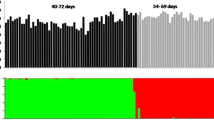Abstract
Quantitative trait loci (QTL) analyses based on restriction fragment length polymorphism maps have been used to resolve the genetic control of flowering time in a cross between twoArabidopsis thaliana ecotypes H51 and Landsbergerecta, differing widely in flowering time. Five quantitative trait loci affecting flowering time were identified in this cross (RLN1-5), four of which are located in regions containing mutations or loci previously identified as conferring a late-flowering phenotype. One of these loci is coincident with theFRI locus identified as the major determinant for late flowering and vernalization responsiveness in theArabidopsis ecotype Stockholm.RLN5, which maps to the lower half of chromosome five (between markers mi69 and m233), only affected flowering time significantly under short day conditions following a vernalization period. The late-flowering phenotype of H51 compared to Landsbergerecta was due to alleles conferring late flowering at only two of the five loci. At the three other loci, H51 possessed alleles conferring early flowering in comparison to those of Landsbergerecta. Combinations of alleles conferring early and late flowering from both parents accounted for the transgressive segregation of flowering time observed within the F2 population. Three QTL,RLN1,RLN2 andRLN3 displayed significant genotype-by-environment interactions for flowering time. A significant interaction between alleles atRLN3 andRLN4 was detected.
Similar content being viewed by others
References
Atherton JG (1987) Manipulation of flowering. Butterworths Scientific Publications, London
Barthelmess I (1960) Merkmalskorrelation und Selektion beiArabidopsis thaliana (L.) Heynh. Z Pflanzenzucht 52:273–332
Burn JE, Smyth DR, Peacock WJ, Dennis ES (1993) Genes conferring late flowering inArabidopsis thaliana. Genetica 90:147–155
Chang C, Bowman JL, DeJohn AW, Lander ES, Meyerowitz EM (1988) Restriction fragment length polymorphism linkage map forArabidopsis thaliana. Proc Natl Acad Sci USA 85: 6856–6860
Clarke JH, Dean C (1994) MappingFRI, a locus controlling flowering time and vernalization. Mol Gen Genet 242: 81–89
De Vicente MC, Tanksley SD (1993) QTL analysis of transgressive segregation in an interspecific tomato cross. Genetics 134:585–596
Dierks W (1958) Untersuchungen zum Heterosisproblem. Z Pflanzenzucht 40:67–102
Haldane JBS (1919) The combination of linkage values, and the calculation of distances between the loci of linked factors. J Genet 8:299–309
Härer L (1950) Die Verebung des Blähalters früher und später sommereinjähriger Rassen vonArabidopsis thaliana (L.) Heynh. Beitr Biol Pflanzen 28:1–35
Koornneef M (1990)Arabidopsis thaliana In: O'Brian ST (ed) Genetic maps (locus maps of complex genomes) Book 6, Plants. Cold Spring Harbor Laboratory Press, Cold Spring Harbor New York, pp 6.94–6.97
Koornneef M, Hanhart CJ, van der Veen JH (1991) A genetic and physiological analysis of late flowering mutants inArabidopsis thaliana. Mol Gen Genet 299:57–66
Koornneef M, Blankestijin-de Vries H, Hanhart C, Soppe W, Peeters T (1994) The phenotype of some late-flowering mutants is enhanced by a locus on chromosome 5 that is not effective in the Landsbergerecta wild type. Plant J 6: 911–919
Kowalski SP, Lan T-H, Feldmann KA, Paterson AH (1994) QTL mapping of naturally occurring variation in flowering time ofArabidopsis thaliana. Mol Gen Genet 245:548–555
Lander ES, Botstein D (1989) Mapping Mendelian factors underlying quantitative traits using RFLP linkage maps. Genetics 121:185–199
Lander ES, Green P, Abrahamson J, Barlow J, Daly MJ, Lincoln SE, Newburg L (1987) MAPMAKER: an interactive computer package for constructing primary genetic linkage maps of experimental and natural populations. Genomics 1: 174–181
Lee I, Bleeker A, Amasino R (1993) Analysis of naturally occurring late flowering inArabidopsis thaliana. Mol Gen Genet 237:171–176
Lee I, Aukerman MJ, Gore SL, Lohman KN, Michaels SD, Weaver LM, John MC, Feldmann KA, Amasino RM (1994a) Isolation ofLUMINIDEPENDENS: a gene involved in the control of flowering time inArabidopsis. Plant Cell 6:75–83
Lee I, Michaels SD, Masshardt AS, Amasino RM (1994b) The late flowering phenotype ofFRIGIDA and mutations inLUMINIDEPENDENS is suppressed in the Landsberg erecta strain of Arabidopsis. Plant J 6:903–909
Lincoln SE, Lander ES (1990) Mapping genes controlling quantitative traits using MAPMAKER/QTL. A Whitehead Institute for Biomedical Research technical report, 1st edn
Lister C, Dean C (1993) Recombinant inbred lines for the mapping of RFLP and phenotypic markers inArabidopsis thaliana. Plant J 4:745–750
Meyerowitz EM (1987)Arabidopsis thaliana. Annu Rev Genet 21:93–111
Napp-Zinn K (1957) Untersuchungen zur Genetik des Kältebedürfnisses beiArabidopsis thaliana. Z Indukt Abst Vererb 88:253–285
Napp-Zinn K (1961) Über die Bedeutung genetischer Untersuchungen an kältebedürftigen Pflanzen für die Aufklärung von Vernalisationserscheinungen. Züchter 31:128–135
Napp-Zinn K (1969)Arabidopsis thaliana (L.) Heynh In: Evans LT (ed) Introduction to flowering. MacMillan, Melbourne, pp 291–304
Napp-Zinn K (1979) On the genetical basis of vernalization requirement inArabidopsis thaliana (L.) Heynh In: Physiologie de la floraison, No. 285. Editions du CNRS, pp 217–220
Paterson AH, Lander ES, Hewitt JD, Peterson S, Lincoln SE, Tanksley SD (1988) Resolution of quantitative traits into Mendelian factors by using a complex linkage map of restriction fragment length polymorphisms. Nature 335:721–726
Redei GP (1962) Supervital mutants ofArabidopsis. Genetics 47:433–460
Redei GP (1992) A heuristic glance at the past ofArabidopsis genetics In: Koncz C, Chua N-H, Schell J (eds) Methods in tArabidopsis research. World Scientific, Singapore, pp 1–15
Seyffert W (1960) Untersuchungen über die Vererbung quantitativer Charaktere anArabidopsis thaliana (L.) Heynh. Z Pflanzenzucht 42:356–401
Stuber CW, Lincoln SE, Wolff DW, Helentjaris T, Lander ES (1992) Identification of genetic factors contributing to heterosis in a hybrid from two elite maize inbred lines using molecular markers. Genetics 132:823–839
Tanksley SD (1993) Mapping polygenes. Annu Rev Genet 27:205–233
Author information
Authors and Affiliations
Additional information
Communicated by D. M. Lonsdale
Rights and permissions
About this article
Cite this article
Clarke, J.H., Mithen, R., Brown, J.K.M. et al. QTL analysis of flowering time inArabidopsis thaliana . Molec. Gen. Genet. 248, 278–286 (1995). https://doi.org/10.1007/BF02191594
Received:
Accepted:
Issue Date:
DOI: https://doi.org/10.1007/BF02191594




